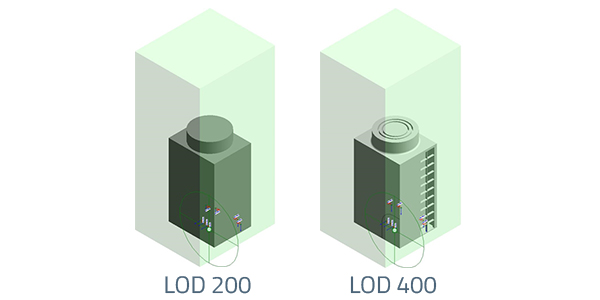The term BIM started to invade the construction world a few years ago.
Originally, BIM effectively meant a 3D symbols library, and a BIM object was the digital modelling of an air-conditioning unit, a window, or a concrete block. Data quickly entered onto the scene, making BIM an information and property catalyst, turning the way we think about construction today on its head.
Implementing Building Information Modeling brings many benefits to the construction industry. However, it is important to use quality and functional BIM objects. Architects, design offices and construction companies have everything to gain.
Quality BIM objects – making the link between players
The promise of BIM is to facilitate the cooperation of all the players around a construction project in a centralised manner. The first quality of a BIM object is therefore to use a common language between the various project participants. In particular between architects, engineers, builders and building managers.
A quality BIM object allows for better collaboration between the different project participants. By having access to accurate and up-to-date information, all parties involved in a joint project can work more efficiently.
Also, in order to be readable by all, the properties of the BIM object must be structured in a standardised way according to formats compatible with the software of each participant. This is the main challenge for manufacturers and the condition for their objects to be qualitative.
Reducing costs, improving efficiency and quality of projects
Cost optimisation
The quality and functional BIM object contains all the information relating to a construction product. This information is then distributed to the entire value chain involved in the digital model. Namely the 3D model for the architect or the thermal information for the thermician or electrical information for the electrician. This accurate and up-to-date information allows all these actors to avoid costly mistakes.
Indeed, a functional BIM object allows to simulate the different aspects of the project and to detect potential problems before construction. This reduces costs by minimising defects and delays.
In addition, by having access to detailed information about the materials, equipment and systems used in the project, construction professionals can better plan long-term maintenance and avoid costly breakdowns.
Better quality of work
By using BIM tools for design, architects, designers and builders can improve the quality of the work. But how?
First of all, it is important to ensure that specifications and standards are respected. Secondly, it is also important to optimise air circulation and natural lighting. But also to plan the use of space more efficiently.
Interoperability and adaptability
From design to operation, the behaviour of the qualitative and functional BIM object must be adapted to the level of development of the digital mock-up. For example, an air conditioning unit will be represented by a simple geometric cube with a basic level of information at the beginning of the project. Then, progressively with a higher level of information, including complex properties as time goes by.
Example: Hitachi exterior group depicted in LOD 200 and LOD 400 
In the same way, the BIM object must be able to cater to the specific features of each type of software, like, for instance, the possibility of managing multiple layers in REVIT software.
How do you evaluate the success of your BIM object? Do an IFC export to generate the digital model – if the data remains structured and doesn’t undergo any loss, you have succeeded.
Understand BIM in order to succeed
The challenge for manufacturers is to create objects whilst being aware that many potential partners will be brought in to be involved on it. In order to do this, manufacturers must begin by understanding what a BIM object is. This is to challenge their partners, and ask their clients about the software they use in order to adopt the appropriate standards and formats.
Understanding formats and software is not an option for successful BIM objects. It is a prerequisite to be recognised as a reliable manufacturer by users of digital mock-ups. Find out in our article how the use of BIM for manufacturers is necessary to stand out and sell more.
One of BIM&CO’s distinctive features is having identified the classification of existing objects, and the software and properties required by this software. Once they have been referenced, this knowledge base is regrouped within a unified dictionary. Thanks to this, each property can be named in a standardised way and can therefore be exploited by any software, whatever the country. That’s one way of undoing the ‘Tower of Babel’ effect!
What to remember about quality and functional BIM objects?
In short, the use of a quality and functional BIM object allows construction companies to improve the quality, efficiency and profitability of their construction projects, by taking advantage of the benefits of digital tools.
Do you want to transform your product catalogue into BIM objects, or have free access to quality and functional BIM objects? Whether you are a manufacturer, an architect or a design office, our team at BIM&CO will be happy to assist you in this process.



